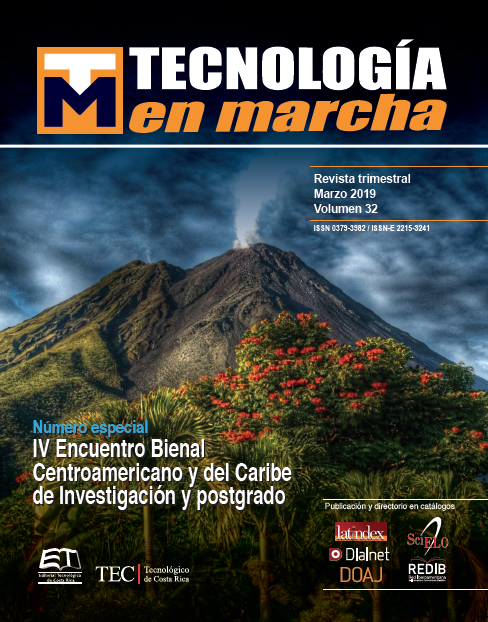Behavior of an aluminum foam as an attenuator of electromagnetic radiation
Main Article Content
Abstract
Electromagnetic interference affects the proper functioning of electronic devices. New cellular materials are showing their shielding potential from electromagnetic radiation interference due to their mechanical and energy absorption characteristics which, combined with a high electromagnetic wave reflection coefficient and good electrical conductivity, make them a useful material for this kind of application.
The objective of this work is to analyze the behavior of an open cell metal foam as an attenuator of electromagnetic radiation by using computer simulation in ANSYS Electromagnetics. The physical system is modeled in a medium composed of air, with the selected material being aluminum; subsequently the system is subjected to dynamic electromagnetic fields produced by a linear antenna. The results obtained show that, from an incident magnetic and electric field of 1A/m and 5V/cm respectively, the behavior in magnitude of these fields is reduced as they enter the material matrix, down to values of 0.0691A/m for the magnetic field and 0.6573V/cm for the electric field.
Article Details
Los autores conservan los derechos de autor y ceden a la revista el derecho de la primera publicación y pueda editarlo, reproducirlo, distribuirlo, exhibirlo y comunicarlo en el país y en el extranjero mediante medios impresos y electrónicos. Asimismo, asumen el compromiso sobre cualquier litigio o reclamación relacionada con derechos de propiedad intelectual, exonerando de responsabilidad a la Editorial Tecnológica de Costa Rica. Además, se establece que los autores pueden realizar otros acuerdos contractuales independientes y adicionales para la distribución no exclusiva de la versión del artículo publicado en esta revista (p. ej., incluirlo en un repositorio institucional o publicarlo en un libro) siempre que indiquen claramente que el trabajo se publicó por primera vez en esta revista.
References
A. Ameli, M. Nofar, S. Wang, y C. B. Park, «Lightweight polypropylene/stainless-steel fiber composite foams with low percolation for efficient electromagnetic interference shielding», ACS Appl. Mater. Interfaces, vol. 6, n.o 14, pp. 11091–11100, 2014.
Z. Xu y H. Hao, «Electromagnetic interference shielding effectiveness of aluminum foams with different porosity», J. Alloys Compd., vol. 617, pp. 207–213, 2014.
L. Catarinucci, G. Monti, y L. Tarricone, «Metal foams for electromagnetics: experimental, numerical and analytical characterization», Prog Electromagn Res B, vol. 45, pp. 1–18, 2012.
O. Losito, «An analytical characterizzation of metal foams for shielding applications», PIERS Online, vol. 4, n.o 8, pp. 805–810, 2008.
O. Losito, D. Barletta, y V. Dimiccoli, «A wide-frequency model of metal foam for shielding applications», IEEE Trans. Electromagn. Compat., vol. 52, n.o 1, pp. 75–81, 2010.
G. Monti, L. Catarinucci, y L. Tarricone, «New materials for electromagnetic shielding: Metal foams with plasma properties», Microw. Opt. Technol. Lett., vol. 52, n.o 8, pp. 1700–1705, 2010.
J. Iniguez, V. Raposo, A. García Flores, M. Zazo, y P. Hernández-Gómez, «Advantages of the Use of Metal Foams for Electromagnetic Shielding», en Key Engineering Materials, 2013, vol. 543, pp. 125–128.
ANSYS. An Introduction to HFSS. Canonsburg, PA 15317: ANSYS Inc. and ANSYS Europe. 2016.
M. Polyanskiy, «RefractiveIndex. INFO-Refractive index database», Refract. INFOOnline Available Httprefractiveindex InfoAccessed 25 Jan 2016, 2018.

